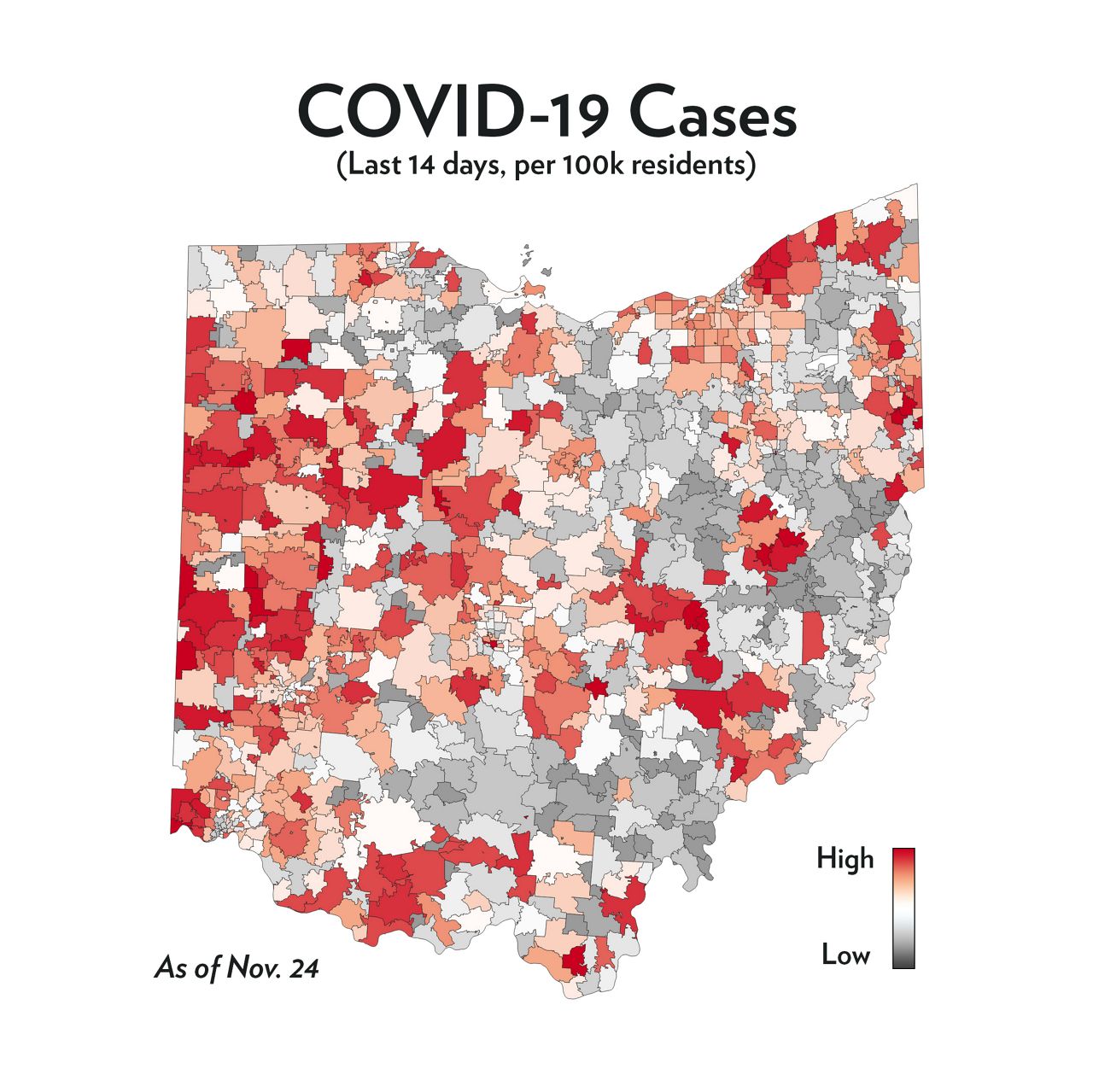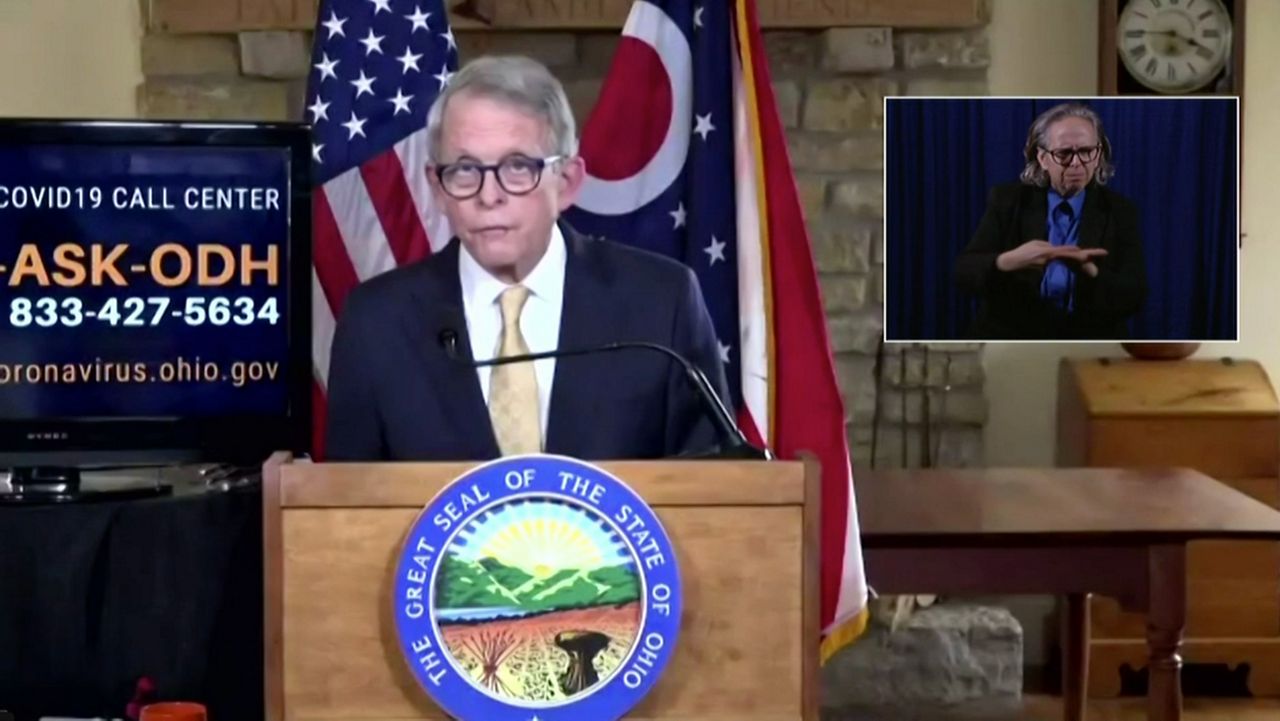COLUMBUS — Ohio reported 8,604 cases and 98 deaths Tuesday, the highest daily death report since Apr. 29.
Gov. Mike DeWine said on Tuesday he sees no signs the state’s high rates of spread are slowing.
“We have not a hit a plateau. We wish we were at a plateau, but there’s no indication. The positivity rate continues to go up and the cases continue to go up,” DeWine said.
The governor announced Tuesday the state is asking schools to play winter sports in empty gyms at least until the end of the year.
“It allows our student athletes to continue to play, which as a parent, a grandparent, is the most important thing,” DeWine said.
At press briefing that featured COVID-19 patients, the governor shared that Ohio expects the first batch of Pfizer’s vaccine to arrive in the state around Dec. 15. He said Moderna’s vaccine is expected to arrive a week later.
“We have a date that looks pretty definite, pretty certain,” DeWine said.
The state expects a continuous flow of doses in batches by the thousands, which will be administered at 10 sites around the state.
Hospitals around the state received Eli Lilly’s monoclonal antibody treatment last week, and began infusions within 12 hours of arrival, according to the Ohio Department of Health. The treatment is available to a select number of patients with mild or moderate symptoms.
Ohio reported 4,449 patients were hospitalized with COVID-19, while 1,046 were in ICU beds, and 598 patients were on ventilators.
Schools cannot safely allow crowds to winter sports that are held indoors, DeWine said. Allowing fans into high school gyms could create new environments for the coronavirus to spread. Schools will have the choice to let parents watch games in-person.
Ohio reported 364 new hospitalizations on Tuesday. A new dashboard released Monday shows 1 in 4 hospital patients in the state are COVID-19 positive, as that rate has increased 613% in the last two months.
Zip code level date shows the highest rates of spread in the last two weeks. The western part of the state is largely deep red.

Urban areas have seen cases surge too, including Frankin County, which was the first in the state to enter the “purple” zone on a county by county advisory map.
Two weeks ago, the governor said he would have to close indoor dining if trends continued. But opting for more limited restrictions than states which have closed dining and schools, DeWine is calling his measures a “slow down” not a shutdown.
DeWine said improved mask wearing gave him hope a shutdown could be averted. The governor has tightened the mask mandate and turned on a curfew, hoping the measures will be enough to protect hospitals from becoming overwhelmed.
The governor again spoke encouragingly Tuesday of reports on mask compliance, sharing that state representatives have randomly inspected retail rural, urban, and suburban areas, finding 90% mask compliance since the mandate was tightened.
The state has fallen behind in its processing of positive antigen tests, causing the Department of Health to put an asterisk on the last several days of case reporting. On Tuesday, DeWine said the number of tests in the backlog is about 6,000, down from 15,000 as of the last update.
Hospital officials said staffing levels have become strained as thousands of health care workers need to quarantine, with shortages impacting 27% of hospitals.
One of those health care workers, a 37-year-old respiratory therapist suffering continued complications and requiring oxygen, shared the story of her sickness at the governor’s briefing.
Stephanie Marshall, who works at OhioHealth Grant Medical Center, said her husband dropped her off at the emergency room when her condition quickly declined. Marshall had pneumonia in both lungs. She wondered if she was saying goodbye to her family for the last time.
At the hospital, she was told she would need to go on a ventilator. She begged to not be intubated, and she utlimately recovered from the worst symptoms. Now, she says her seven year old child is learning how to adjust her oxygen machine, which aides her breathing.
The governor responded to the state’s positivity rate climbing to a seven day average of 13.5 percent, nearing a key figure of 15%, which is the number that triggers other states to be on Ohio’s list for travel quarantines. Would hitting that number trigger closures, he was asked.
“No, not a lockdown, but I’ll tell you—that data point, I hope gets peoples’ attention in Ohio,” DeWine said. “This number is what the medical professionals, health professionals tell us is very, very dangerous. We’re going to be living in such a state.”



